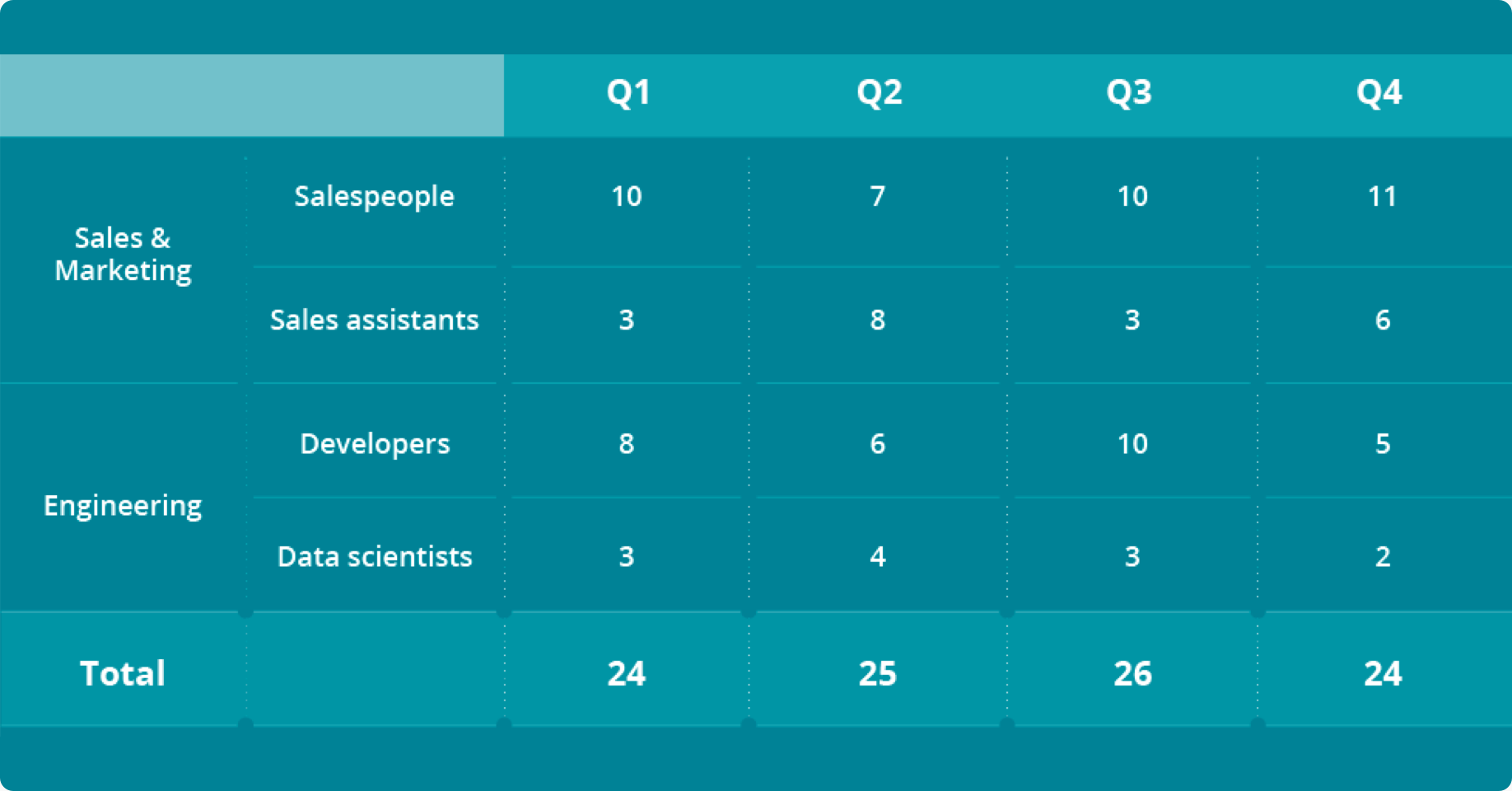Whether you work for a small startup or a massive enterprise with thousands of employees, you need to know how your team is going to grow over time—in other words, who you’re going to hire and when.
That’s why you should develop a recruitment plan to help streamline your hiring processes and make sure you have access to the talent you need when you need it.
A strategic recruitment plan is not only important for filling job vacancies, but also because poor recruitment decisions can be costly.
A bad hire can cost up to 30% of the employee’s potential first-year earnings.
– U.S. Department of Labor
By taking a proactive approach and building out a plan for your recruiting in advance, you can save time and money and make sure your team doesn’t find themselves short-handed down the road.
The question is: how can you develop a recruitment plan that reflects the dynamic nature of the contemporary job market and anticipates future staffing needs, so that you can proactively plan ahead?
Keep reading to find out the steps you need to take to develop and implement a scalable recruitment plan at your company!
What’s in?
What is a recruitment plan?
Recruitment plans are about much more than just knowing what roles need to be filled in the near future—they’re an opportunity to align company goals and skill gaps with your hiring efforts in order to strategically plan for the year ahead.
A strategic recruitment plan should include the positions you need to hire for, a recruitment calendar, budget information, tracking and assessment tools, and other important details about how you’ll manage your recruiting efforts.
Steps to creating a successful recruitment plan
It’s clear that building out a recruitment strategy is the best way to rethink and improve your hiring practices—but many companies fail to plan accordingly.
To help you navigate the planning process, here are 11 steps to creating a successful recruitment plan.
1. Analyze recruitment needs and skill gaps
The first step to creating a recruitment plan is to identify your hiring needs and where there are skill gaps that your existing talent can’t fill.
Start by analyzing the growth of your company, taking into consideration important factors like employee turnover and anticipated promotions, as they will impact your hiring needs.
Estimate which departments and roles will need strengthening and why. Is a key member of the team leaving? Will a new project be kicking off?
By learning which skills your team will be missing and the ones you’ll need to tackle the future workload, you can take a proactive approach that better aligns hiring with staffing needs.
2. Create a hiring plan and recruitment calendar
Next, you can put your analysis into practice and estimate how many people each department will need and approximately when they’re needed.
This will help you plan ahead and anticipate future needs in time to prepare for them. For example, if you need to fill a role in Q3, you might need to start your preparations in Q2 to make sure you fill the position in time.
With this information, you can build out a full recruitment calendar for the year. This should include the positions you’ll need to hire for per quarter, total headcount for each department, and a hiring timeline for when each round of hiring will begin.

This is how you can visualize your hiring plan to always stay on top of your recruitment efforts.
3. Identify the tools you need for a scalable recruitment process
Now that you have a recruitment calendar and a hiring plan, you can identify the tools you’ll need to execute your plan.
Some of the most critical solutions for your recruitment tech stack are an applicant tracking system (ATS), accounts on various online job boards, pre-employment assessment and screening tools, and analytics or BI software for data-driven decisions.
These tools will help your team organize and streamline your company’s hiring efforts, automating time-consuming tasks and improving the candidate screening process.
The Harver platform, for example, automates the hiring processes, from candidate screening to interview scheduling to reference checking. With our recruiting software, you can eliminate repetitive tasks such as reading resumes and moving candidates further in the process.
Moreover, you can optimize your talent pool by collecting data on the profiles of your applicants and comparing it with the profiles of your best performing employees. With our assessment tools, you can easily see the matching scores of applicants, and you get insights on your full recruitment funnel.

4. Determine the requirements for each position
With a solid idea of which roles you’ll be hiring for, you can begin determining the requirements for each job opening.
What are the characteristics and skills that you want job candidates to have? What will their daily responsibilities be? And their goals?
To make sure everyone is on the same page and decrease time to hire, you should meet with hiring managers and talk through this step together. This will help you develop a thorough understanding of each role and what the needs are to fill it effectively.
For example, if you’re hiring for a contact center, you might want to recruit people with transferable skills, in case you need to need to move employees from chat agent to phone agent roles.
To do this efficiently and at scale, you need to look further than your current openings and think at your company culture and the general skills people should have to be a good fit.
So instead of recruiting people who only fit a specific opening, you assess candidates to see what their skills and characteristics are, and then you assign them to the vacancies that fit their skill set the best.
We call this approach call-type matching.

You can learn more about this recruitment strategy in our webinar on the future of volume hiring in BPOs and Contact Centers.
5. Build out a budget for recruitment costs
Based on your previous cost per hire, you can estimate how much your recruitment costs are going to be for the year ahead. Bear in mind various costs involved in the recruitment process that you’ll need to account for in your budget.
Some of the common recruiting costs include:
- Advertising on job boards and social media
- Job fairs and campus recruiting costs
- Recruiting technology costs
- Employer branding expenses
- In-house salaries and benefits of the involved
- Background checks and drug tests
- Recruitment travel expenses
Once you’ve finished with these general steps of your recruitment plan, you can proceed to a role-specific plan with the steps below.
6. Start with a compelling job description
Attracting the best candidates all starts with a strong job description. However, many companies take the wrong approach. They list the specific job requirements and expectations, but fail to share anything about what the company has to offer, possibly discouraging job seekers from applying.
Avoid this mistake and instead, aim to write compelling and inclusive job descriptions that will appeal to job seekers. They should include information about your company’s mission and values, along with the specifics for the role.
Don’t be afraid to show some personality—remember job descriptions are an opportunity to sell the job to potential candidates.

7.6 million
That’s how many jobs are currently open in the U.S.
Source: Bureau of Labor Statistics
In order to stand out, your job posting has to be compelling and creative.
7. Establish a candidate selection process
Next, you should think about how you’re going to handle the tricky task of candidate selection. We’ve covered this topic thoroughly in our e-book below.
Stop guessing,
Start data-driven hiring.
Learn how you implement a modern candidate selection process, that is: streamlined, experience-driven and backed by data.

Clearly define how the overall process will work by establishing how many interview rounds you’ll have and who will be tasked with interviewing and selecting candidates.
That said, you shouldn’t use a one-size-fits-all selection process for choosing candidates. Rather, you should look for different ways to personalize the experience for each candidate.
You can do this by considering what questions, needs, or concerns they might have throughout the interview and selection process and proactively addressing them.
Pre-employment assessments are a great resource for selecting qualified candidates early on and moving them along in the selection process.
There are many different types of assessments, from personality questionnaires to determining cognitive ability and cultural fit. There are even gamified assessments, like Harver’s gamified behavioral assessment that engages job seekers while identifying soft skills.
Check out the online application experience Netflix created using the Harver platform, and think how a similar pre-selection method would benefit your application process.
8. Conduct background and reference checks
Once you’ve selected a candidate, you should conduct a background check as needed. This may not always be necessary, depending on company policies and the role you’re hiring for.
Determine whether background checks will be needed early on, as this will help to avoid potential process delays down the road.
You should make it a point to check references, which are a way of assessing organizational fit and confirming their qualifications. They essentially help to confirm your internal assessment of whether or not a candidate is a good fit for the organization. See how to complete reference checks with only 2 minutes of recruiter time >
During reference checks, try to ask open-ended questions about performance, accomplishments, and difficulties to learn as much as possible from the reference.
9. Make an offer to the chosen candidate
As part of your overall recruitment plan, you should define who will make the offer and further negotiate with the chosen candidate. By determining how this will go in advance, you can ensure a much smoother candidate experience.
First, you should call or email your ideal candidate and offer the position. Once you have confirmation that your candidate will be accepting the role, it’s common to follow up with an official offer letter that outlines the agreement in writing.
10. Define what happens after the job is accepted
That’s the last step in the plan, right? Wrong! The best recruitment plans don’t stop with the offer letter. As you wrap up your plan, define what will happen after the job is accepted.
Who is going to take care of preboarding and onboarding? By answering these questions in advance and having a plan in place, you can make seamless transitions from candidate to employee.
11. Learn and optimize your plan as you go
Lastly, you should leverage new hire feedback and analytics to inform your recruitment plan and optimize it accordingly.
Send out an anonymous survey to collect feedback from new hires. How was the interview and selection process? What part of the process was done well and what part could have been better?
You can also make good use of your hiring analytics. Review key recruitment metrics like time to hire, quality of hire, early turnover rates, and cost per hire. Then find ways you can improve your recruitment process based on those insights.
Just like the 21st-century job market and the recruiting industry are always evolving, your recruitment plan should also develop over time.

270
That’s how many people have to view your job posting on average to get 1 hire.
Source: Jobvite
…and don’t forget that a corporate job opening can attract up to 250 applicants on average. Your recruiting game must be continuously optimized to bring you the best results.
A concluding thought
A recruitment plan should be the ultimate guide for your recruitment efforts. It may take time and effort to create one; however, don’t think it’s final once you’re finished. You should adapt and optimize your plan based on the business’ needs and how they fluctuate over time.
For example, what if your company grows faster than expected and you need to hire more people than you originally expected? Or what if you decide to implement a brand new technology?
Continue working on your recruitment plan, measuring key metrics and enhancing it as you go to achieve the best possible results.
Like what you see?
Don’t miss out. Subscribe to our quarterly digest to get the latest TA and TM resources delivered right to your inbox.




